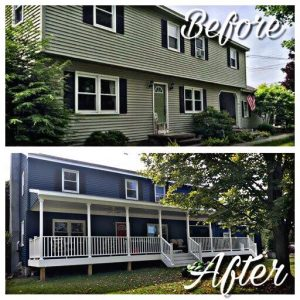For many homeowners, a fresh coat of paint is a simple, ideal way to refresh the look of their home. But what if your home has aluminum or vinyl siding that doesn’t look as vibrant as it used to? The good news is that your siding doesn’t have to be replaced – like other surfaces, it can be given new life with a coat of paint, and you can save both time and money in the process!
Below are a few simple tips to keep in mind when painting your home’s siding.

Painting Your Home’s Siding
Preparing for the process of painting your aluminum or vinyl siding is the key to making the new look last. A new coat of paint is an investment of your time and money, so preserve the finished product by preparing for the work ahead of time.
1. Select Your Paint
The first important consideration is the selection of paint that you will use for your siding, which will depend on whether your home has aluminum or vinyl siding. For aluminum or metal siding, acrylic latex paint with a flat or satin finish is recommended. If you are working with vinyl siding, acrylic paint in a shade that is lighter than the color of the siding will work best. Darker colors absorb more heat, which may lead to warping of the siding. Some manufacturers even carry paints that are designed to be used specifically with certain types of siding. Doing your research and looking into what types and colors of paints are available for your home’s siding will help you to make the best decision.
2. Prepare the Surface
The next important step to take is to make sure the surfaces of your vinyl or aluminum siding are clean and free of dirt, mildew, mold, and chalk. The paint will adhere best to a smooth, clean surface. Power washing is the quickest way to thoroughly clean your home’s siding, though it is important to be mindful of the pressure used so that you do not damage the siding or force water under the siding panels near doors, windows, and vents. Use overlapping strokes, moving from the top of your home to the bottom. Once all siding has been washed, don’t forget to rinse the panels so that no residue is left behind, then allow the siding to dry completely over one or two days.
3. Primer
Whether the next step of applying primer to your home’s siding is needed will depend on the siding’s specific condition. While primer is typically used to ensure that the paint will stay adhered to the surface it is being applied to, it is not always necessary when painting vinyl or aluminum siding. Older vinyl siding, or siding that is pitted or deteriorating, may benefit from an application of primer. Similarly, weathered or aging aluminum siding may need primer more than newer siding. Inspect the condition of your home’s siding or consider consulting with a professional before deciding whether primer will be used.

4. Protect Surfaces
Lastly, you will need to protect your doors, windows, and lighting fixtures by using painter’s tape and plastic sheeting. Covering these areas will ensure that they are not damaged during the painting process and will minimize the amount of clean-up that will be needed after the painting is done.
Contact Us for More Information About Our Exterior Painting Services near Glens Falls, NY
When you’ve decided that it’s time to improve your home’s curb appeal, painting vinyl or aluminum siding instead of replacing is a cost-effective way to upgrade the look of your home. While these tips are the most important to consider when undertaking the exterior painting process, there are many factors that can influence how successful the paint application will be, such as the condition of your siding and what colors will work best. That’s why we recommend consulting with a professional to ensure that the investment you make into your home will last for years to come.
If you’d like to schedule a consultation for your next exterior painting job, give us a call at (518) 415-5845 or contact us online today!






